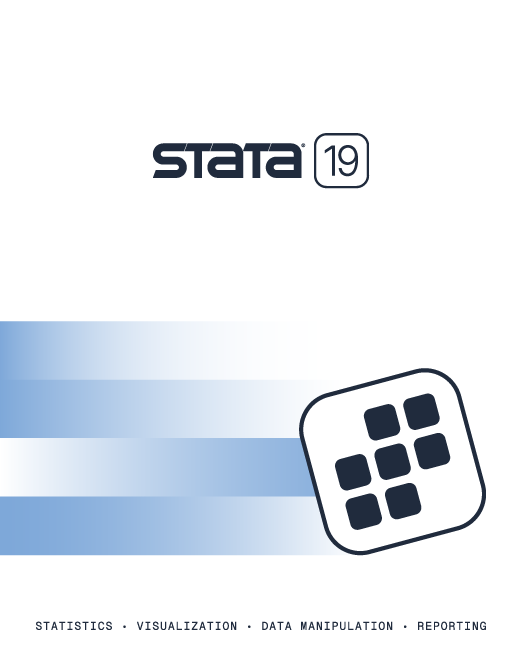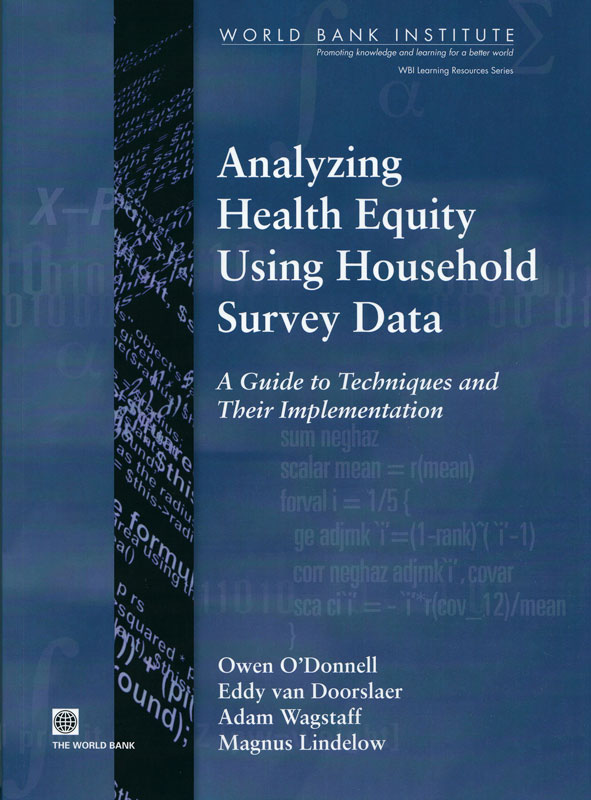

2025 Stata Conference • Nashville, TN • 31 July–01 August
Analyzing Health Equity Using Household Survey Data: A Guide to Techniques and Their Implementation |
||||||||||||||||||||||||||||||||||||
 Click to enlarge See the back cover |

As an Amazon Associate, StataCorp earns a small referral credit from
qualifying purchases made from affiliate links on our site.
eBook not available for this title
eBook not available for this title |
|
||||||||||||||||||||||||||||||||||
Comment from the Stata technical groupThe study of health equity has been increasingly popular over the past 25 years, evidenced in the threefold increase of Medline-published topics. The authors thoroughly cover the important concepts of biostatistics, economics, and survey statistics—three areas in which Stata excels—and how to use Stata to implement the analysis. Part I of the three-part text mainly covers how to measure health outcomes. Topics include estimating standardized mortality rates (infant and child), constructing and interpreting anthropometric indicators, measuring self-reported adult health in relation to socioeconomic status, measuring the standard of living, and adjusting these estimates and measures for survey data. Part II outlines the possible analyses when presenting results on health equity, including analysis using concentration curves, concentration indices, and their extensions; and analysis decomposing health inequities into their underlying inequalities. For instance, child survival inequalities likely reflect inequalities in education, health insurance, and health-care access, among others. Part III covers analyzing equity in health care utilization and health care spending using the techniques described in Part II. |
||||||||||||||||||||||||||||||||||||
Table of contentsView table of contents >> Foreword ix
Preface xi
1. Introduction
The rise of health equity research
The aim of the volume and the audience Focal variables, research questions, and tools Organization of the volume References 2. Data for Health Equity Analysis: Requirements, Sources, and Sample Design
Data requirements for health equity analysis
Data sources and their limitations Examples of survey data Sample design and the analysis of survey data The importance of taking sample design into account: an illustration References 3. Health Outcome #1: Child Survival
Complete fertility history and direct mortality estimation
Incomplete fertility history and indirect mortality estimation References 4. Health Outcome #2: Anthropometrics
Overview of anthropometric indicators
Computation of anthropometric indicators Analyzing anthropometric data Useful sources of further information References 5. Health Outcome #3: Adult Health
Describing health inequalities with categorical data
Demographic standardization of the health distribution Conclusion References 6. Measurement of Living Standards
An overview of living standards measures
Some practical issues in constructing living standards variables Does the choice of the measure of living standards matter? References 7. Concentration Curves
The concentration curve defined
Graphing concentration curves—the grouped-data case Graphing concentration curves—the microdata case Testing concentration curve dominance References 8. The Concentration Index
Definition and properties
Estimation and inference for grouped data Estimation and inference for microdata Demographic standardization of the concentration index Sensitivity of the concentration index to the living standards measure References 9. Extensions to the Concentration Index: Inequality
Aversion and the Health Achievement Index
The extended concentration index
Achievement—trading off inequality and the mean Computing the achievement index References 10. Multivariate Analysis of Health Survey Data
Descriptive versus causal analysis
Estimation and inference with complex survey data Further reading References 11. Nonlinear Models for Health and Medical Expenditure Data
Binary dependent variables
Limited dependent variables Count dependent variables Further reading References 12. Explaining Differences between Groups: Oaxaca Decomposition
Oaxaca-type decompositions
Illustration: decomposing poor–nonpoor differences in child malnutrition in Vietnam Extensions References 13. Explaining Socioeconomic-Related Health Inequality
Decomposition of the Concentration Index
Decomposition of the concentration index Decomposition of change in the concentration index Extensions References 14. Who Benefits from Health Sector Subsidies? Benefit Incidence Analysis
Distribution of public health care utilization
Calculation of the public health subsidy Evaluating the distribution of the health subsidy Computation References 15. Measuring and Explaining Inequity in Health Service Delivery
Measuring horizontal inequity
Explaining horizontal inequity Further reading References 16. Who Pays for Health Care? Progressivity of Health Finance
Definition and measurement of variables
Assessing progressivity Measuring progressivity Progressivity of overall health financing Computation References 17. Redistributive Effect of Health Finance
Decomposing the redistributive effect
Computation References 18. Catastrophic Payments for Health Care
Catastrophic payments—a definition
Measuring incidence and intensity of catastrophic payments Distribution-sensitive measures of catastrophic payments Computation Further reading References 19. Health Care Payments and Poverty
Health payments–adjusted poverty measures
Defining the poverty line Computation References |
||||||||||||||||||||||||||||||||||||
Learn
Free webinars
NetCourses
Classroom and web training
Organizational training
Video tutorials
Third-party courses
Web resources
Teaching with Stata
© Copyright 1996–2025 StataCorp LLC. All rights reserved.
×
We use cookies to ensure that we give you the best experience on our website—to enhance site navigation, to analyze usage, and to assist in our marketing efforts. By continuing to use our site, you consent to the storing of cookies on your device and agree to delivery of content, including web fonts and JavaScript, from third party web services.
Cookie Settings
Last updated: 16 November 2022
StataCorp LLC (StataCorp) strives to provide our users with exceptional products and services. To do so, we must collect personal information from you. This information is necessary to conduct business with our existing and potential customers. We collect and use this information only where we may legally do so. This policy explains what personal information we collect, how we use it, and what rights you have to that information.
These cookies are essential for our website to function and do not store any personally identifiable information. These cookies cannot be disabled.
This website uses cookies to provide you with a better user experience. A cookie is a small piece of data our website stores on a site visitor's hard drive and accesses each time you visit so we can improve your access to our site, better understand how you use our site, and serve you content that may be of interest to you. For instance, we store a cookie when you log in to our shopping cart so that we can maintain your shopping cart should you not complete checkout. These cookies do not directly store your personal information, but they do support the ability to uniquely identify your internet browser and device.
Please note: Clearing your browser cookies at any time will undo preferences saved here. The option selected here will apply only to the device you are currently using.